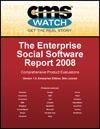 I have to admit – when my copy of the Enterprise Social Software and Collaboration Report 2009 from CMS Watch arrived, I was a bit daunted when I heaved the envelope – this thing seemed like a doorstop. I opened it and typically just fanned open to a few pages, catching glimpses of catalog-like inventory pages on various enterprise software products… honestly? Is this just a huge, expensive collection of RFP responses? Having other reading material ahead of it in line, I set it on the pile. Honestly, I procrastinated a bit before tackling it.
I have to admit – when my copy of the Enterprise Social Software and Collaboration Report 2009 from CMS Watch arrived, I was a bit daunted when I heaved the envelope – this thing seemed like a doorstop. I opened it and typically just fanned open to a few pages, catching glimpses of catalog-like inventory pages on various enterprise software products… honestly? Is this just a huge, expensive collection of RFP responses? Having other reading material ahead of it in line, I set it on the pile. Honestly, I procrastinated a bit before tackling it.
Big mistake.
When I finally dove in I was pleasantly surprised. The extensive introduction is a fantastic foundational read for anyone getting into social software or social media in an enterprise setting. There are well over 100 pages of detailed analysis on topics such as the business case for social software, a vivisection of social software types and services, and scenario-based vignettes of social software. There is an extremely deep dive into the actual inventory of software products and platforms, with descriptions, ratings, feature matrices and screenshots. And in classic fashion, the executive summary is saved until the end.
What’s so great about this report is that it is more enterprisey than wonk-ish. Of course, social software is still new-but-busting-into many large enterprises. The Social Software Report is a playbook for this market. The analysts provide fantastic feature descriptions and real-world usage patterns, but also cover fun topics like Compliance in detail just as great. Describing the differences between real-time versus cached LDAP credentials from both compliance- and point-of-failure angles is Good Stuff for the Enterprise Architect. Covering archiving is good (they do this), but doing it within a section called “Lifecycle Management” shows you they get it.
There are suitably large sections on the big platform vendors (30-ish pages on Sharepoint), since many enterprises own one or many of those already. But there is still plenty of coverage on best-of-breeds like SocialText and Jive. Detailed functional reviews are followed by technical architecture descriptions – which, I know from my own tedious research experience, don’t always jump off the vendor sites at you.
If you are engaged in any explorations of social software, don’t make the same mistake I did. If you are going through a selection process, it’s ridiculous to not check this report out. But even if you have constrained options or a preferred vendor that’s already a done deal – this report will flesh out your understanding of the marketplace for social software enough to get you kicked out of the next BarCamp for being a suit.
Good stuff, this report – check it out!
Technorati tags: social software, social media, cms watch, enterprise 2.0, web 2.0, collaboration, research, industry analysts








Recent Comments